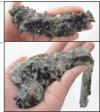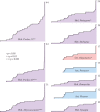Phylotranscriptomic analysis uncovers a wealth of tissue inhibitor of metalloproteinases variants in echinoderms
- PMID: 27017967
- PMCID: PMC4807446
- DOI: 10.1098/rsos.150377
Phylotranscriptomic analysis uncovers a wealth of tissue inhibitor of metalloproteinases variants in echinoderms
Abstract
Tissue inhibitors of metalloproteinases (TIMPs) help regulate the extracellular matrix (ECM) in animals, mostly by inhibiting matrix metalloproteinases (MMPs). They are important activators of mutable collagenous tissue (MCT), which have been extensively studied in echinoderms, and the four TIMP copies in humans have been studied for their role in cancer. To understand the evolution of TIMPs, we combined 405 TIMPs from an echinoderm transcriptome dataset built from 41 specimens representing all five classes of echinoderms with variants from protostomes and chordates. We used multiple sequence alignment with various stringencies of alignment quality to cull highly divergent sequences and then conducted phylogenetic analyses using both nucleotide and amino acid sequences. Phylogenetic hypotheses consistently recovered TIMPs as diversifying in the ancestral deuterostome and these early lineages continuing to diversify in echinoderms. The four vertebrate TIMPs diversified from a single copy in the ancestral chordate, all other copies being lost. Consistent with greater MCT needs owing to body wall liquefaction, evisceration, autotomy and reproduction by fission, holothuroids had significantly more TIMPs and higher read depths per contig. Ten cysteine residues, an HPQ binding site and several other residues were conserved in at least 70% of all TIMPs. The conservation of binding sites and the placement of echinoderm TIMPs involved in MCT modification suggest that ECM regulation remains the primary function of TIMP genes, although within this role there are a large number of specialized copies.
Keywords: ECM; Echinodermata; Holothuroidea; MCT; MMP; collagen.
Figures





References
-
- Nerlich AG, Bachmeier BE. 2007. The tissue inhibitors of metallo-proteinases (TIMPs)—history, structure and function. In New developments in metastasis suppressor research (ed. Jackson P.), pp. 289–308. New York, NY: Nova Science Publishers, Inc.
-
- Brew K, Dinakarpandian D, Nagase H. 2000. Tissue inhibitors of metalloproteinases: evolution, structure and function. Biochim. Biophys. Acta 1477, 267–283. (doi:10.1016/S0167-4838(99)00279-4) - DOI - PubMed
-
- Lambert E, Dassé E, Haye B, Petitfrère E. 2004. TIMPs as multifacial proteins. Crit. Rev. Oncol./Hematol. 49, 187–198. (doi:10.1016/j.critrevonc.2003.09.008) - DOI - PubMed
-
- Takehana Y, Yamada A, Tamori M, Motokawa T. 2014. Softenin, a novel protein that softens the connective tissue of sea cucumbers through inhibiting interaction between collagen fibrils. PLoS ONE 9, e85644 (doi:10.1371/journal.pone.0085644) - DOI - PMC - PubMed
-
- Wilkie IC. 2005. Mutable collagenous tissue: overview and biotechnological perspective. In Echinodermata, pp. 221–250. Berlin, Germany: Springer. - PubMed
LinkOut - more resources
Full Text Sources
Other Literature Sources
Research Materials
Miscellaneous

